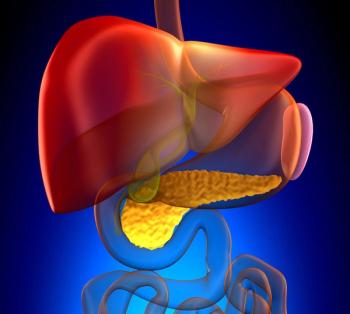
Tool Combining Genomics, AI May Predict Future Prostate Cancer Recurrence
A combined genomic and histological analysis within trial datasets demonstrates a sound tumor evaluation strategy for patients with prostate cancer.
Combining genomics with artificial intelligence (AI)-aided histopathology was shown to identify clinical biomarkers of evolution to help predict prostate cancer recurrence even decades after diagnosis, according to investigators from the phase 1 IMRT study (NCT00946543) published in Nature Center.
Topline data in the study shows that independent predictors of recurrence were genetic (HR, 3.12; 95% CI, 1.34-7.3) and morphological (Gleason) diversity (HR, 2.24; 95% CI, 1.28-3.92), which together identified a group with half the median time to recurrence. Additionally, an independent marker of recurrence was spatial segregation of clones (HR, 2.3; 95% CI, 1.11-4.80). Copy number changes associated with Gleason grade were identified and investigators found reduced immune infiltration was associated with chromosome 6p loss.
A total of 471 patients with high-risk or locally advanced prostate cancer were recruited for the IMRT clinical trial. They received the standard of care for radiation treatment of prostate cancer, neoadjuvant/adjuvant androgen deprivation therapy and intensity-modulated radiotherapy to the prostate and pelvic lymph nodes. This population had a previously reported recurrence rate of 40%.
Individuals were selected with available tissue blocks and an associated hematoxylin and eosin (H&E)-stained section (n = 250) from the IMRT cohort. Patients with at least 3 biopsies containing cancer tissue at 70% purity or more for sequencing were selected from the set (n = 114). A final set of 111 patients had available sequencing data after 3 were excluded due to genomic library preparation failure.
Additionally, 3 patients were included from the DELINEATE trial (ISCTN04483921) to assess spatial tumor variation extent. A total of 48 needle biopsies, all of which were collected and reviewed by a specialist uropathologist were available per case.
The median follow-up was 12.5 years following radiotherapy. Investigators outlined recurrence as a biochemical-only recurrence with a prostate specific antigen (PSA) level of 2 ng ml–1 or more above the nadir PSA after radiotherapy in the absence of disease observed on imaging. The time to recurrence was the completion date of radiotherapy to first recurrence.
Low-pass whole-genome sequencing (WGS) was performed in 642 tumor samples with a median of 5 per patient. Samples were from the combined 114 patients from both trial sets, which the study referred to as the sequencing cohort. Additionally, WGS was performed for fresh-frozen buffy coat samples from a UK genetic prostate cancer trial (NCT017372420, n =100) with a median coverage of 36x. Computational histopathology analysis was performed on 1,923 H&E sections from the total population of 250 patients, including all from the IMRT trial.
In successful targeted sequencing within the sequencing cohort (n = 107), mutations in a putative prostate cancer driver gene in at least 1 sample were found in 61 patients, with 74.9% of mutations detected in patients with 3 or more biopsies classified as subclonal. A ratio of non-synonymous to synonymous substitutions (dN/dS) analysis indicated significant positive selection for subclonal truncating mutations (dN/dS = 2.06; 95% CI, 1.01-4.19).
TP53 (n = 6)and SPOP (n = 5) contained the most common clonal mutations, with significant positive selection across all substitution types affiliated with these genes (TP53, q = 2.42 × 10−5; SPOP, q = 7.46 × 10−4). When only considering truncating mutations, CDKN1B and TP53 were under positive selection (CDKN1B, dN/dS = 35.4; 95% CI,1.8–266; TP53, dN/dS = 33.3; 95% CI, 8.3–123).
When analyzed with copy number profiles, genomic patterns confirm the multifocality of the disease. MDM2 (n = 4), MYCN (n = 4), and FGFR1(n = 3)hadrecurrent focal amplifications. Multiple heterogeneity and genomic instability metrics were calculated and then computed before unblinding of outcome data. Of note, TP53 was associated with higher burden of chromosomal alterations (0.069 greater proportion genome altered in TP53-mutant samples, P = 0.0007).
The number of copy number alteration (CNA) events in the phylogenetic tree predicted a shorter time to recurrence in the univariate analysis (P = 0.027) with a median time to recurrence of 7.2 years and 11.5 years, respectively. The upper tertile of the Spearman heterogeneity index (P = 0.017) showed a shorter time to recurrence of 7.1 years and 11.5 years, respectively. Furthermore, Spearman heterogeneity was confirmed in multivariate analysis for time to recurrence to be a powerful independent prognostic factor (HR, 3.12; 95% CI, 1.34-7.3; P = 0.009).
Using an automated Gleason classifier, gland-level Gleason grade was called in 1923 sections from 250 IMRT trial patients. Regions were dominated by Gleason patterns 3, 4, and 5.
Spatial heterogeneity of Gleason pattern was measured with the Morisita Index. Low Gleason Morisita scores identified biopsies with segregated Gleason patterns and high scores highlighted biopsies with greater mixing of Gleason grades within the same patch. Gleason Morisita was significantly robust to multivariate analysis and prognostic (Gleason Morisita HR, 2.45; 95% CI, 1.32-4.56 vs conventional marker HR, 2.04; 95% CI, 1.38-3.03).
There was no association between Gleason pattern 5 and Gleason Morisita (P = .83). Additionally, invasive ductal patterns were significantly prognostic (HR, 1.8; 95% CI, 1.22-2.66; P = .003). However, this was independent of Gleason Moristia which was significant.
“We report that spatial genomic and morphological divergence were significantly associated with recurrence. Thanks to the clinical trial design, we could ensure that these metrics were robust to multivariate analysis. In the future, these ‘evolvability’ metrics could be used in conjunction with established clinical variables as well as commercially available transcriptomic tests to optimally predict recurrence in prostate cancer, particularly for individuals with high-risk or locally advanced disease,” George Cresswell, PhD, principal investigator at St. Anna Children’s Cancer Research Institute and joint first author concluded with study coauthors.
Reference
Fernandez-Mateos J, Cresswell GD, Trahearn N, et al. Tumor evolution metrics predict recurrence beyond 10 years in locally advanced prostate cancer. Nat Center. Published July 12, 2024. doi:10.1038/s43018-024-00787-0
Newsletter
Stay up to date on recent advances in the multidisciplinary approach to cancer.


















































































